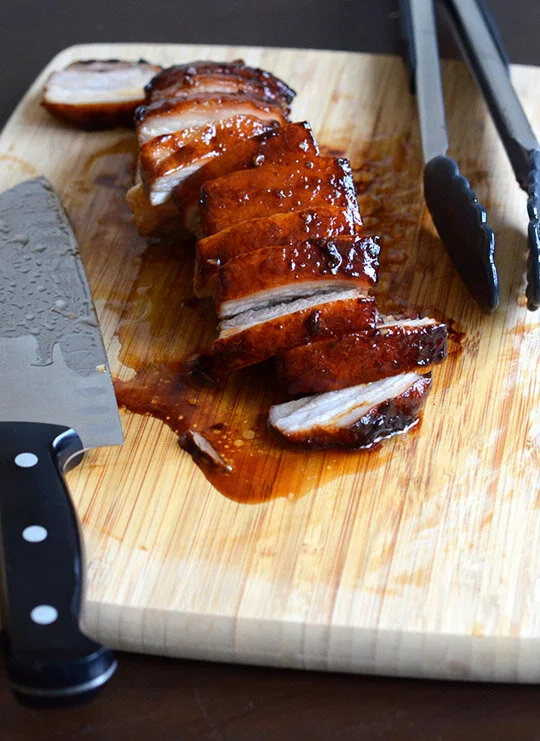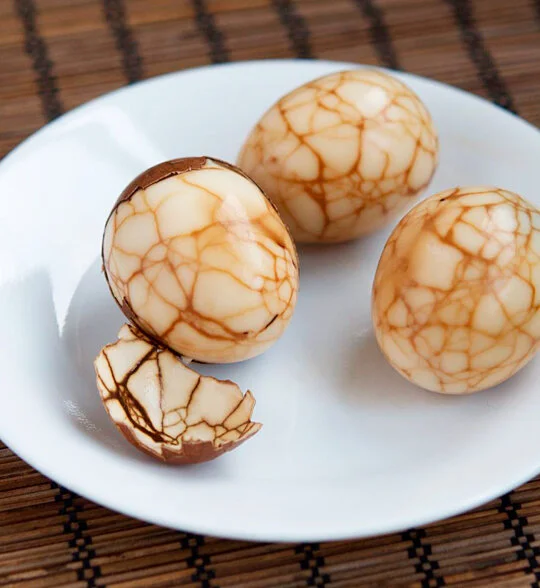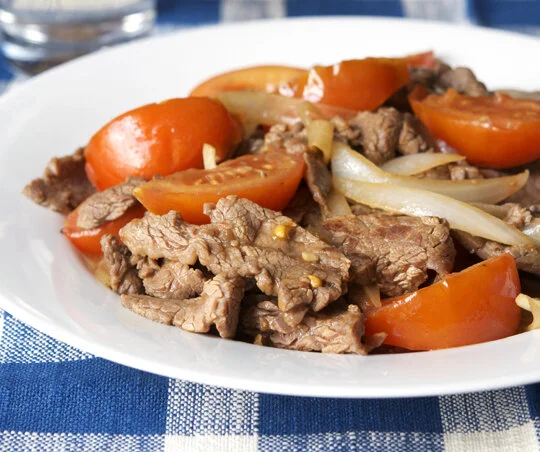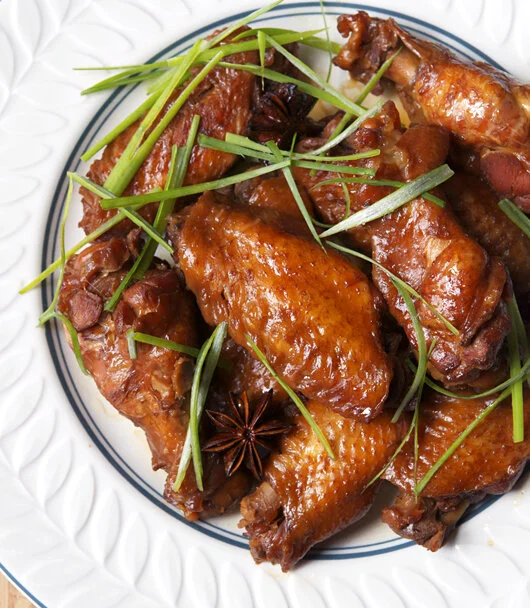The secret to getting flaky layers is all in the folding. Try out this easy Chinese scallion pancake method along with my go-to dipping sauce.
Read MoreFor the fourth video in my Chinese cooking video series, I decided to make a family recipe that's also one of the most popular in my new book The Chinese Takeout Cookbook. It's a quick fun video set to American folksy music, a nod to the Chinese cooking culture here in the U.S. dating from the late 19th and early 20th centuries. Enjoy!
Along with wonton noodle soup, char siu (Chinese barbecued pork or Chinese roast pork) is the Cantonese people's greatest contribution to mankind. Really, who can resist slices of half-fatty, half-lean roast pork, crisp and dripping with caramelized juices? (I first posted this recipe for Chinese Barbecued Pork back in February 2009 and it became an instant hit.)
You know those enticing pieces of pork dangling in Chinatown restaurant windows? When you get char siu at a Cantonese restaurant, it will most likely be red from a little food dye, used to attract customers. A small amount of dye isn't harmful (think of all those M&Ms and Skittles you've eaten). But sometimes a restaurant will go overboard. My mother still has nightmares of glowing magenta char siu from Boston's Chinatown.
Read MoreLove egg drop soup? For the second video in the new Appetite for China Cooking Videos series, I decided to update this post with a fun visual guide on making egg drop soup with tomatoes. Let me know what you think!
I first made tomato egg drop soup in 2008 while living in Beijing during the Summer Olympics. At the time, I was in desperate need of something light and healthy for lunch to go with a salad, to counteract all the fried food I had been eating at the Olympic venues. And what could be more healthy and comforting at the same time than tomatoes and eggs in homemade chicken broth? Over the years I've tweaked the recipe bit by bit and come up with this revised version.
There are few ingredients in this soup, so it's important that the chicken stock (or vegetable stock) be homemade. (You can use either Chinese or Western homemade stock.) If you must use store-bought, try to find organic stock or broth that does not have too many preservatives in the label.
Read MoreChinese marbled tea eggs are super easy to make at home and the aromas of tea, cinnamon, and star anise are intoxicating.
Read MoreCantonese tomato beef, a Hong Kong classic, is great for nights when you need a fast dinner.
Read MoreBack when I made black pepper beef in Beijing, flank steak was surprisingly difficult to find. Sure, black pepper beef is more of a Cantonese stir-fry, and the Chinese eat pork way more than beef, but somehow I just didn't expect to have to buy all my flank steak at a gourmet market for expats. Luckily, now I'm back in Brooklyn and living within walking distance of at least five big grocery stores, all of which have flank steak in abundance.
Over the years I've altered my recipe (first published July 27, 2008) to include ground black pepper in the sauce instead of the marinade, so the flavor is now more pronounced. The proportions of the sauce ingredients have also been updated; this sauce has less sodium, less sugar, less oil, but still maintains plenty of flavor. Try it out and let me know what you think!
Flank steak is something I hardly ever cook in China, mostly because I am almost never in the vicinity of a good butcher. But last weekend, I decided to treat myself to a massage to help with a sore back. Walking out blissful and somewhat painfree, I realized I was near Boucherie Michel, the only place in town where I could find quality cuts of meat and imported cheeses and wine and pricey organic food. (How I miss the days when I could pop down to the Fairway in West Harlem for all my grocery needs.)
Read MoreReally, who can resist juicy chicken wings braised in a bath of soy sauce, garlic, cinnamon, and star anise?
Read MoreGreetings from Atlanta! I'm down south for BlogHer Food 2011 and getting ready for two days of panels, talks, and events with plenty of other food bloggers from around the country. I got in a few hours ago, wandered around downtown enjoying the sun, and even managed to find and scarf down some Cajun-Chinese food for lunch. (To be recapped in another post.)
Oh, so you may have noticed the new layout. After 3 1/2 years of blogging on Drupal, I finally made the long-overdue switch to Wordpress. I have a feeling this is going to be change my life. Or at least, be a major headache reducer. As flexible as Drupal can be, and as much as tech-savvy folks rave about it, it was not the easiest CMS to work with if all you want to do is blog and not tweak a lot of code. And I sort of really dislike code. I've been working with Wordpress for only a few days and it already feels way more intuitive...kind of like when I switched from a PC to a Mac in 2005 and never, ever looked back.
(One of the best new additions to the new design is a little Print-Friendly button at the end of each post. Just click on it, and a window sans sidebars will pop up, and you can select which elements you want to keep and delete.)
Read MoreI love owning a bamboo steamer, if for no other reason that to display around the kitchen. It's not only a conversation starter whenever new guests visit but also a handy tool for food photography. (Gotta play up the Asian theme sometimes.) Plus, a set of basket and lid usually costs less than $10 in Chinatown.
Of course, there are times when bamboo steamers are useful for actual cooking. Aside from har gow, shumai is possibly the most requested dim sum standard in my family, with the reliable crinkly yellow wonton wrappers snugly encasing the pork-dominant filling. I haven't tackled har gow at home yet, possibly because even 95% of all restaurants I visit fail at the texture of the translucent wrapper. But siu mai I can do.
Read MoreOne of the reasons I love visiting my parents in Zhongshan in Guangdong province is indulging in all the Cantonese food I miss living up north. And rarely do we eat out, although not for lack of good restaurants. Mostly we cook at home, sometimes experimenting, other times cooking old favorites.
Clay pot rice with Cantonese sausage is one of my favorite homestyle favorites. Why eat plain rice when you can gobble up rice flavored with juicy sausages? Called "lap mei fan" or "bo zai fan" in Cantonese, clay pot rice is one of the easiest ways to elevate a weeknight meal, or act as a stand-alone meal.
What kind of sausage can you use? Either of the ones in the photo below: all-pork sausage (the reddish one, and most common kind), or pork and duck (the darker ones, smokier in flavor.) The squarish piece is cured duck meat, like cured ham except different animal. The most common "lap mei fan" includes all three, but you can use just the all-pork sausage, which is easiest to find outside China.
Read MoreWonton noodle soup is one of the few dishes I set very high standards for, almost to the point of obsession. Because of cravings for an ideal bowl of wonton noodle soup (and seeing my relatives), I have paid way too much for same day plane tickets to Hong Kong. When I get wontons that are all or mostly pork, I feel cheated. And I rarely visit wonton noodle stands outside of Hong Kong and Guangzhou, for fear of getting inferior versions.
Yes, it's rather compulsive behavior. But the behavior applies to any sort of a purist, whether the love is sushi, borscht, cocktails, or xiaolongbao. We all have certain foods we put on a pedestal.
If you can't get to Hong Kong, the next best cure for wonton lust is recreating the darn thing at home. After tinkering in the kitchen for over a year and a half, I have updated an older post on this very topic. For me, an ideal wonton noodle soup must include the following: fragrant broth consisting of pork and seafood umami flavor, springy al dente egg noodles, and wontons containing at least 50% shrimp.
Here are the details, if you would like to recreate my ideal Hong Kong-style wonton noodle soup at home.
Read MoreI'm sure most Westerners who have ever dined with a group of Chinese are familiar with the the following scenario. After a ___-course lavish banquet, you look forward to something nice and sweet to cap off a great experience. Your Chinese hosts inform you that you'll love the dessert; all Westerners love dessert. This one is a Chinese specialty. Anticipation mounts. Then the long-awaited dessert arrives...in the form of red bean soup. You take one sip, utter an "Mmm!" with all the false bravado you can muster, and wonder if anyone will notice you "watering" that plant close by.
Yes, it is well known that most Chinese desserts are merely tolerated by Westerners. While I personally don't mind red bean soup or other sweet dessert soups every once in a while, other people, like a certain significant other of mine, have developed an intense fear of them. It's understandable. While in the West we crave and lust after rich chocolates, cakes, and pies, the Chinese palate can tolerate only moderately sweet things. Thus, Chinese desserts never seem sweet enough, but anyone living or traveling extensively in China can't help but encounter them again and again.
Read More
I have to admit that I have a strong bias towards jiaozi (饺子). Besides Shanghainese soup dumplings (xiaolongbao), my favorite Chinese dumplings are thin-skinned and pan-fried, the kind found mainly in Southern China or New York's $1-for-5 fried dumpling joints. Northern Chinese-style dumplings, which offer more thick doughy skin than filling, just can't compare.
What's better than anything a restaurant or dumpling stall can offer are homemade jiaozi, hot off the skillet. On my last day in Zhongshan my mother and I bought dumpling skins from a lady specializing in doughy things like wrappers and noodles, and spent an hour or two wrapping dumplings for dinner.
Since I have so many photos from that afternoon, I thought I would do a pictoral guide on jiaozi-making. (Often dumpling recipes fail to show the step-by-step process in folding.) Also included is my mother's fool-proof method for getting perfectly crisp pan-fried dumplings without burning them.
Read More




